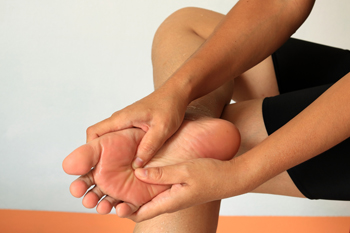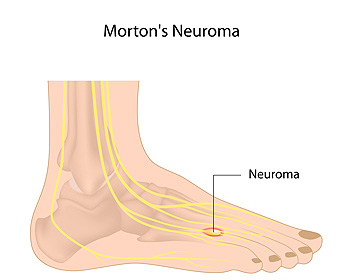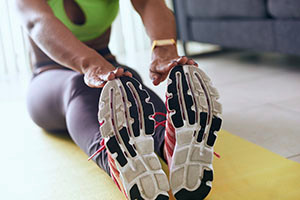 Poor circulation may affect one’s quality of life and can lead to possible health complications if not properly addressed. Some symptoms one may experience if they are dealing with poor circulation of the feet are a possible numbing and tingling feeling in the affected area, swelling of the feet, ankles, or legs, joint and muscle cramping, discoloration of the skin, and ulcers in the legs and feet. Poor circulation may also lead to a feeling of regular fatigue, digestive issues, and possible memory loss or trouble concentrating. If untreated, poor circulation of the feet may lead to serious complications, which is why we recommend it is best that you see a podiatrist for a proper diagnosis and advised recovery regime.
Poor circulation may affect one’s quality of life and can lead to possible health complications if not properly addressed. Some symptoms one may experience if they are dealing with poor circulation of the feet are a possible numbing and tingling feeling in the affected area, swelling of the feet, ankles, or legs, joint and muscle cramping, discoloration of the skin, and ulcers in the legs and feet. Poor circulation may also lead to a feeling of regular fatigue, digestive issues, and possible memory loss or trouble concentrating. If untreated, poor circulation of the feet may lead to serious complications, which is why we recommend it is best that you see a podiatrist for a proper diagnosis and advised recovery regime.
Poor circulation is a serious condition and needs immediate medical attention. If you have any concerns with poor circulation in your feet contact Dr. Richard DiMario of Maine. Our doctor will treat your foot and ankle needs.
Poor Circulation in the Feet
Poor blood circulation in the feet and legs is can be caused by peripheral artery disease (PAD), which is the result of a buildup of plaque in the arteries.
Plaque buildup or atherosclerosis results from excess calcium and cholesterol in the bloodstream. This can restrict the amount of blood which can flow through the arteries. Poor blood circulation in the feet and legs are sometimes caused by inflammation in the blood vessels, known as vasculitis.
Causes
Lack of oxygen and oxygen from poor blood circulation restricts muscle growth and development. It can also cause:
Those who have diabetes or smoke are at greatest risk for poor circulation, as are those who are over 50. If you have poor circulation in the feet and legs it may be caused by PAD and is important to make changes to your lifestyle in order to reduce risk of getting a heart attack or stroke. Exercise and maintaining a healthy lifestyle will dramatically improve conditions.
As always, see a podiatrist as he or she will assist in finding a regimen that suits you. A podiatrist can also prescribe you any needed medication.
If you have any questions please feel free to contact our office located in York, ME . We offer the newest diagnostic and treatment technologies for all your foot and ankle needs.
 If you are experiencing pain on the ball of the foot, it may be indicative of a condition that is referred to as Morton’s neuroma. It is typically caused by irritation that happens to a nerve connected to a toe. It can become thickened, and will most often occur between the second and third toes. It may be common among patients who have flat feet, high arches, or conditions that can include bunions and hammertoes. People who enjoy sporting activities that involve running may also be susceptible to developing this condition. Additionally, skiers or ballerinas may be prone to getting Morton’s neuroma as a result of wearing shoes that put pressure on the ball of the foot. Symptoms that are often associated with this ailment can include a numbing and tingling sensation, and pain or difficulty walking. If you suffer from this condition, please consult with a podiatrist who can properly treat this condition.
If you are experiencing pain on the ball of the foot, it may be indicative of a condition that is referred to as Morton’s neuroma. It is typically caused by irritation that happens to a nerve connected to a toe. It can become thickened, and will most often occur between the second and third toes. It may be common among patients who have flat feet, high arches, or conditions that can include bunions and hammertoes. People who enjoy sporting activities that involve running may also be susceptible to developing this condition. Additionally, skiers or ballerinas may be prone to getting Morton’s neuroma as a result of wearing shoes that put pressure on the ball of the foot. Symptoms that are often associated with this ailment can include a numbing and tingling sensation, and pain or difficulty walking. If you suffer from this condition, please consult with a podiatrist who can properly treat this condition.
Morton’s neuroma is a very uncomfortable condition to live with. If you think you have Morton’s neuroma, contact Dr. Richard DiMario of Maine. Our doctor will attend to all of your foot care needs and answer any of your related questions.
Morton’s Neuroma
Morton's neuroma is a painful foot condition that commonly affects the areas between the second and third or third and fourth toe, although other areas of the foot are also susceptible. Morton’s neuroma is caused by an inflamed nerve in the foot that is being squeezed and aggravated by surrounding bones.
What Increases the Chances of Having Morton’s Neuroma?
Morton’s neuroma is a very treatable condition. Orthotics and shoe inserts can often be used to alleviate the pain on the forefront of the feet. In more severe cases, corticosteroids can also be prescribed. In order to figure out the best treatment for your neuroma, it’s recommended to seek the care of a podiatrist who can diagnose your condition and provide different treatment options.
If you have any questions, please feel free to contact our office located in York, ME . We offer the newest diagnostic and treatment technologies for all your foot care needs.
A foot fracture occurs when one or more bones break slightly or severely. Typical reasons why this type of injury may occur can include falling, having a heavy object land on your foot, or slight cracks may gradually form from standing on a hard surface for most of the day. There are several different types of foot fractures. If the bone should stay in place as it breaks, this is known as a non-displaced fracture. When the bone is fractured in two areas, a displaced break exists. If you have broken your foot in several places, this is referred to as a comminuted fracture. An open fracture exists when the bone is piercing through the skin, and may become infected. There are common symptoms that patients have when they have broken their foot. These can consist of severe pain and discomfort around the affected area, swelling, bruising, and it may be difficult to walk. If you have broken your foot, your podiatrist will perform a proper diagnosis, and can offer treatment solutions.
A broken foot requires immediate medical attention and treatment. If you need your feet checked, contact Dr. Richard DiMario from Maine. Our doctor can provide the care you need to keep you pain-free and on your feet.
Broken Foot Causes, Symptoms, and Treatment
A broken foot is caused by one of the bones in the foot typically breaking when bended, crushed, or stretched beyond its natural capabilities. Usually the location of the fracture indicates how the break occurred, whether it was through an object, fall, or any other type of injury.
Common Symptoms of Broken Feet:
Those that suspect they have a broken foot shoot seek urgent medical attention where a medical professional could diagnose the severity.
Treatment for broken bones varies depending on the cause, severity and location. Some will require the use of splints, casts or crutches while others could even involve surgery to repair the broken bones. Personal care includes the use of ice and keeping the foot stabilized and elevated.
If you have any questions please feel free to contact our office located in York, ME . We offer the newest diagnostic and treatment technologies for all your foot and ankle needs.
 Many people have a strong desire to run in a marathon. Research has indicated the importance of warming up properly as the training regime begins, and this may be helpful in preventing running injuries. An injury to the plantar fascia typically starts by noticing pain in the heel. It is recommended that the calves and arches are properly stretched before beginning the physical training that is necessary to run a marathon. This can help to keep the muscles and tendons flexible. Ankle injuries may be avoided by performing heel drops, which can help to build strength in the ankles. Additionally, it is helpful to wear running shoes that are made of a lightweight material, and have adequate cushioning. If you enjoy the sport of running, and would like additional information about how the feet may be affected by running injuries, please consult with a podiatrist.
Many people have a strong desire to run in a marathon. Research has indicated the importance of warming up properly as the training regime begins, and this may be helpful in preventing running injuries. An injury to the plantar fascia typically starts by noticing pain in the heel. It is recommended that the calves and arches are properly stretched before beginning the physical training that is necessary to run a marathon. This can help to keep the muscles and tendons flexible. Ankle injuries may be avoided by performing heel drops, which can help to build strength in the ankles. Additionally, it is helpful to wear running shoes that are made of a lightweight material, and have adequate cushioning. If you enjoy the sport of running, and would like additional information about how the feet may be affected by running injuries, please consult with a podiatrist.
Exercising your feet regularly with the proper foot wear is a great way to prevent injuries. If you have any concerns about your feet, contact Dr. Richard DiMario of Maine. Our doctor will treat your foot and ankle needs.
How to Prevent Running Injuries
Many common running injuries are caused by overuse and overtraining. When the back of the kneecap starts wearing out and starts causing pain in your knee, this is commonly referred to as runner’s knee. Runner’s knee is a decrease in strength in your quadriceps and can occur if you’re not wearing properly fitted or supporting shoes. To prevent runner’s knee, focusing on hip strengthening is a good idea, as well as strengthening your quads to keep the kneecaps aligned.
What Are Some Causes of Running Injuries?
- One cause of a common running injury is called iliotibial band syndrome.
- Plantar fasciitis is also another common injury.
- Stress fractures can occur from overtraining, lack of calcium, or even your running style.
Best Ways to Prevent Running Injuries
- Wear footwear that fits properly and suits your running needs.
- Running shoes are the only protective gear that runners have to safeguard them from injury.
- Make a training schedule. Adding strengthening exercises as well as regular stretching can help keep you strong and limber and can lessen the possibility of injuries.
- Stretching keeps muscles limber; this will help you gain better flexibility.
If you have any questions please feel free to contact our office located in York, ME . We offer the newest diagnostic and treatment technologies for all your foot and ankle needs.